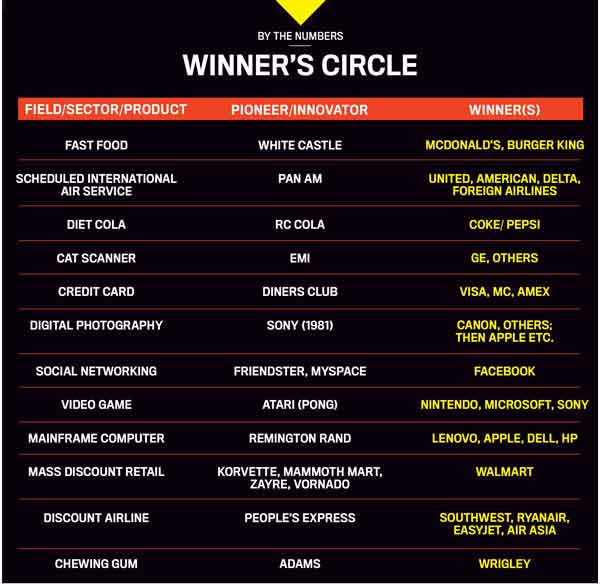BETTER FAST FOOD
Even in deeply entrenched markets like fast food, followers can beat the early movers by giving consumers more choices, better food and more upscale dining environments. Two fast casual—and fast-growing—restaurant chains taking this route are Boloco and Paxti’s Pizza.
Boston-based Boloco sells burritos in an upscale environment, taking its cue from pioneer Chipotle Mexican Grill. Where it differs is in the variety of its fare. “We’ve got more than a dozen
different burritos on the menu besides Mexican,” says Patrick Renna, co-founder and CEO of the chain of 20 restaurants throughout the Northeast. “This way a diner can come here on multiple
occasions, even in a single week, and find something different. They don’t get tired of eating Mexican all the time.”
At San Francisco-based Paxti’s Pizza, founder and CEO Bill Freeman, who had launched several successful Silicon Valley technology startups like United Telecom, watched from the sidelines as the wood-fired pizza craze took shape in the late-1990s and early 2000s. Pizza chain pioneers like Pizza Hut and Domino’s, despite much cheaper prices, were fast losing market share to startups like Seattle’s Tutta Bella, which baked its pies with better ingredients in ovens fed by burning wood, which cook crispier crusts. “Next thing you knew, every town across America had a small pizza chain with wood-fired ovens,” Freeman says.
With money not a problem and lots of time on his hands, the successful entrepreneur was eager to enter the market with a childhood friend, Francisco “Paxti” Aspiroz. The latter had heard about a revolutionary electric oven manufactured in Italy that quickly reached a temperature of 800 degrees, much hotter than a wood-fired oven. It also cost less to operate than both gas-fired and wood-burning ovens, and delivered cooked pies in 30 percent less time. “Our motto is ‘better before cheaper, and revenue before cost,’” Freeman says.
The founders launched Paxti’s Pizza in 2004 in Berkeley, California. It didn’t hurt that the original office of Facebook was next door or that its founder Mark Zuckerberg survived on its pies (smudged boxes bearing the company’s name can be seen in the movie The Social Network). Today, there are 14 Paxti’s restaurants in the Pacific Northwest, and three more under construction.
In both cases, innovative latecomers like Boloco and Paxti’s were able to take advantage of the pioneering brands’ perceived shortcomings. “The innovator does most of the work, invests the greatest amount in R&D, prepares the market and makes the most mistakes,” says Shenkar. “For this they get the early returns. But, unless they maintain continuous innovation and continually lower costs, someone is sure to come in, copy what you do best and innovate the rest.”
WILL PATIENCE REWARD?
Fast followers will not make a dent in or dominate a market unless they have resources, infrastructure and relationships. Freeman had the money, expertise and agility to hit the ground running. So did Hollender, who possessed distribution savvy and sharp marketing skills. In another mature market—household products—in 1988, he founded Seventh Generation, which makes products from biodegradable plant-based materials. With Sustain, he is simply leveraging the same message of sustainability and natural resource conservation, not to mention
many of the same retail channels.
Cordtz also had strong ties to distributors, in his case with hundreds of taverns and restaurants across the country, thanks to his previous job as national sales manager for Thames America, a British maker of hard cider. He had similar contacts in liquor stores and other establishments selling wine and beer. He also had the inside savvy to buy state-of-the-art fermenting equipment from a manufacturer in China he knew, at a discount. The machines were reengineered using sensors and data analytics to reduce labor costs.
“It would be a stretch to say we had a second-to-market strategy,” Cordtz says. “Hard cider was once the largest alcoholic beverage category in America, a position that lasted until Prohibition. We’re just coming at the market with something different.”
He has a point. In many ways, fast followers aren’t reinventing the wheel. They’re simply making better products to customers’ tastes, whether it’s airplanes, pizza or condoms. First acts get the audience going. Second acts get the applause.

Chief Executive Group exists to improve the performance of U.S. CEOs, senior executives and public-company directors, helping you grow your companies, build your communities and strengthen society. Learn more at chiefexecutivegroup.com.
0

1:00 - 5:00 pm
Over 70% of Executives Surveyed Agree: Many Strategic Planning Efforts Lack Systematic Approach Tips for Enhancing Your Strategic Planning Process
Executives expressed frustration with their current strategic planning process. Issues include:
Steve Rutan and Denise Harrison have put together an afternoon workshop that will provide the tools you need to address these concerns. They have worked with hundreds of executives to develop a systematic approach that will enable your team to make better decisions during strategic planning. Steve and Denise will walk you through exercises for prioritizing your lists and steps that will reset and reinvigorate your process. This will be a hands-on workshop that will enable you to think about your business as you use the tools that are being presented. If you are ready for a Strategic Planning tune-up, select this workshop in your registration form. The additional fee of $695 will be added to your total.

2:00 - 5:00 pm
Female leaders face the same issues all leaders do, but they often face additional challenges too. In this peer session, we will facilitate a discussion of best practices and how to overcome common barriers to help women leaders be more effective within and outside their organizations.
Limited space available.

10:30 - 5:00 pm
General’s Retreat at Hermitage Golf Course
Sponsored by UBS
General’s Retreat, built in 1986 with architect Gary Roger Baird, has been voted the “Best Golf Course in Nashville” and is a “must play” when visiting the Nashville, Tennessee area. With the beautiful setting along the Cumberland River, golfers of all capabilities will thoroughly enjoy the golf, scenery and hospitality.
The golf outing fee includes transportation to and from the hotel, greens/cart fees, use of practice facilities, and boxed lunch. The bus will leave the hotel at 10:30 am for a noon shotgun start and return to the hotel after the cocktail reception following the completion of the round.